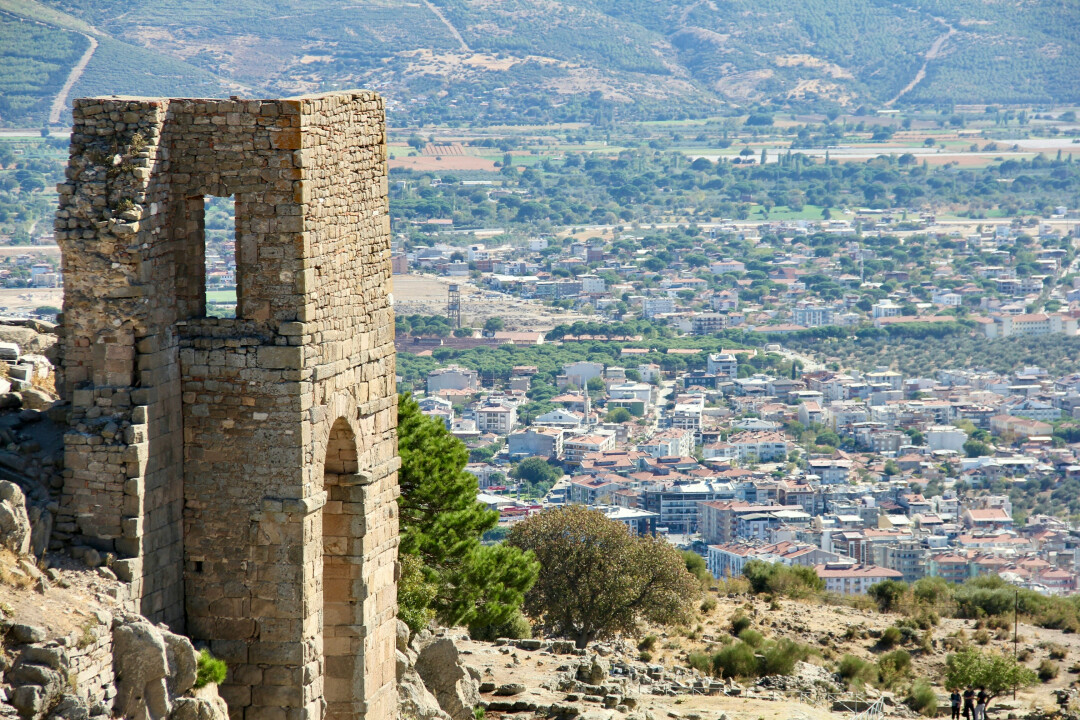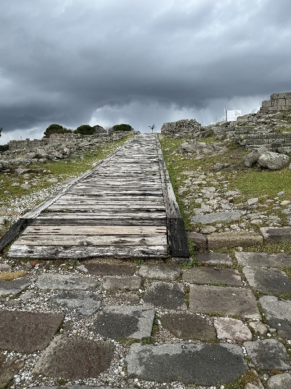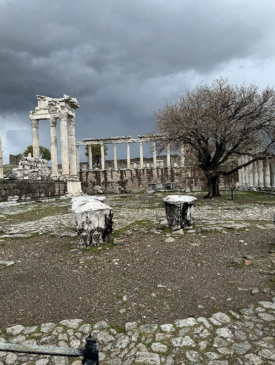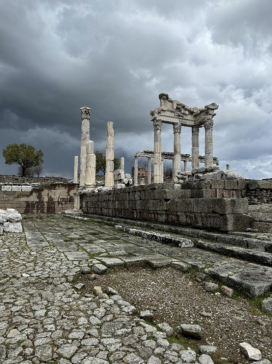
by Leigh Ann Dilley on July 24, 2024
Read Revelation 2:12-17
The third church to receive a letter in Revelation is Pergamum, present-day Bergama. In my opinion, Pergamum was the mot beautiful setting of the seven cities. It sat on the top of a mountain, known as an acropolis, 1,000 feet above the plains that surrounded it. We had to take a gondola to get to the top of it.

This sidewalk was the last set of steps to climb to get to the top of the Pergamum acropolis. It was a cloudy day with lightning. It was scary to be on top of this mountain.
Pergamum was a strong center for paganism. They had an immense altar for Zeus (god of sky and lightning), Dionysus (god of wine), Demeter (god of food and crops), Asklepios (god for healing and health), and Athena (god of wisdom( to name just a few. The first century was a time of Roman emperor worship, and large temples were constructed to honor them. Pergamum was no exception and, in fact, was the first city to build a temple to the emperor: the Temple of Trajan.


The Temple of Zeus is on the left in the first picture. The Temple of Trajan, built to worship the Roman Emperor Trajan, is on the right. In the second photo, you will see another view of the Temple of Zeus in the foreground with the Temple of Trajan behind it.
Other notable structures include the library, which held over 200,000 volumes of books, and the theater which held 10,000 seats. This was the steepest theatre in Asia minor.
Due to Ceasar's influence and the influence of all the false gods, Christians had a hard time in Pergamum. This letter opens with the words from "Him, who has the sharp, double-edged sword." From scripture, we have learned a double-edged sword is symbolic of the Word of God, or truth. The Word is living and active and pierces the soul and spirit. This greeting is a proclamation that it comes from the One who is the truth! The one, true God.
"I know where you live, where Satan has his throne." Satan's throne refers to the abundance of false. gods. The letter says: You have some Nicolaitans who follow the same teaching as Balaam. This takes a little explanation. Balaam was an Old Testament prophet, though not a very good one. At the same time, Balak was king of the Midianites. Midianites occupied the promised land before the Israelites. King Balak didn't want the Israelites to enter the promised land, so he bribed the prophet Balaam to curse them. Both men knew this would be challenging since the Israelites were blessed by God.
Balaam tried to curse the Israelites three times. Every time Balaam opened his mouth to curse the Israelites, only blessings (therefore truth) came out. When the curses didn't work, the prophet Balaam instructed King Balak to encourage the people in their sin; specifically eating food sacrificed to idols and sexual immorality. They thought the sin would cause God to curse His people Himself. Let's just say this ends badly: five Midianite kings and Balaam were killed. Read about it in Numbers 24-25.
The letter says God does not like the practice of the Nicolaitans. The Nicolaitans' doctrine assumed that since Christ redeemed believers, they lived under grace, which is true. But they also believed that living under grace meant they didn't have to take the laws of Moses seriously and could continue sinning through the practices of sexual immorality and idolatry. Sadly, this mindset continues in Christianity today. Christians of Pergamum were told to repent or Christ would come and fight against them with the sword of His mouth (or the truth of His word). This message still stands for Christians today.
Overcomers will receive "hidden manna and a white stone with a new name written on it, known only to him who receives it."
What's with the manna hidden and the white stone? In scripture, manna sustained God's people for 40 years in the desert. Maybe the manna is said here to be hidden because only those who know Christ know the truth of where their strength and sustainability come from (their manna).
The white stone with a new name? White stones were used for many things in biblical times. They were put into ballot boxes to cast votes. They were also used as invitations. Names were engraved on white stones to provide entrance to an ancient festival, celebration, game, or party. First-century believers were not invited to these events, so they did not receive white stone invitations. As an overcome, they will receive the white stone!
New names were often given in biblical times. Think of Abraham, Sarah, Jacob, Peter, and Paul. New names symbolize transformation or a change in one's identity. New names symbolize participation in God's plan. Salvation is personal, and only for those who know Christ and whom Christ knows will be given an invitation and a new name. This entire letter is about the truth. It starts with the double-edged sword, the truth of God's word. It returns to truths about blessing and grace in the middle and ends with a new name for those who know God's strength, sustainability, and truth.
A new name! What name might symbolize your transformation? It's worth thinking about.



